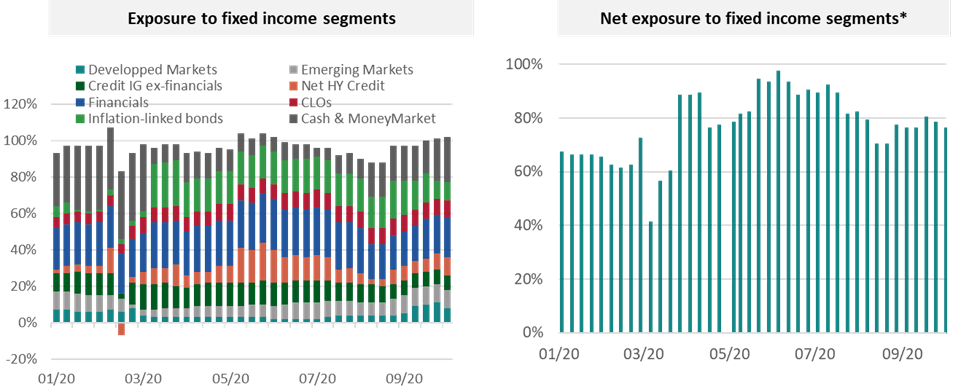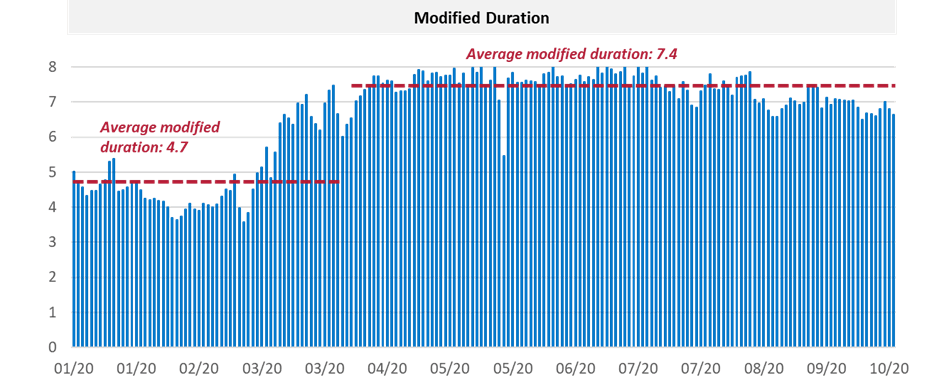Focus Fonds

Carmignac P. Unconstrained Euro Fixed Income: the Fund Manager’s thought
Since March 10th, 2021, the new name of Carmignac Portfolio Unconstrained Euro Fixed Income is Carmignac Portfolio Flexible Bond.
The bond market today
After the disruption caused in the first half of the year by the Covid-19 outbreak, the third quarter seemed more placid. Yet it also saw quite a few developments with an impact on bond-market behaviour as almost all market segments booked substantial gains over the period.
-
The Covid-19 pandemic so dramatically affected global economic activity that it drove government and monetary institutions across the board to provide large-scale support.
-
In July, for example, the EU at last agreed on a Recovery Fund that set the stage for ambitious fiscal stimulus programmes. With the number of persons infected by Covid-19 worldwide rising by the end of summer, governments began preparing for a probable second wave, adopting protective policies that would impact the economy, despite the publication of better than expected economic indicators and some progress on vaccines.
US fixed income has in particular felt the impact of the recent policy shift at the Federal Reserve. To help achieve his inflation and job-growth targets, the Fed would now tolerate brief phases of economic overheating and therefore temporary increases in the inflation rate to over 2%. This announcement was enough to steepen the yield curve and strongly support Inflation-linked securities.
Another factor affecting US fixed income has been the country’s feverish political climate with no agreement reached on a new stimulus bill and no clear outlook on the upcoming presidential election. Emerging-world bond markets showed dispersion, but overall credit risk is on the mend being buoyed by US dollar depreciation and by the rebound in commodities.
Portfolio allocation
The effects of the economic downturn have been offset by stimulus policies introduced around the world, leading us to invest heavily during the second quarter in various parts of the credit space. By early July, corporate credit accounted for 64% of our fixed-income allocation. With central banks engaged in an increasingly pronounced economic support drive, we took inflation-linked bonds to 19% of our portfolio at the start of July to benefit from rising inflation expectations and falling real interest rates. We thus entered the third quarter with 91% exposure to the fixed-income market and negligible cash holdings – a sign of the many opportunities the market had to offer at that point.

*Investments – hedging via derivatives – cash & cash equivalents
Source: Carmignac, 09/10/2020
Buoyed by support from governments and central banks, high-risk credit spreads tightened fast, especially in high-yield (+3%) and subordinated financial debt (around +4%) markets. This convinced us to take profits and scale back our exposure to high-yield credit to an exposure at around 9% now.
We have nonetheless left corporate bonds at nearly 50% of our portfolio with two main convictions:
- Some issuers whose businesses took a direct battering from the Covid-19 outbreak (e.g., certain carmakers, aircraft manufacturers, etc.) with significant performance potential.
- Financial bonds, particularly the more junior issues, as they are receiving extremely generous support from central banks and are still benefiting from their efforts over the past several years to clean up their balance sheets.
This ongoing monetary policy easing should sustain low volatility in markets – a plus point for carry strategies. With that in mind, we have made a large investment in Italian government paper (9%), given that political risk is now off the country’s medium-term agenda.
During the quarter, we raised our exposure to emerging-market bonds focusing now on what are the team’s major convictions: the Mexican oil company Pemex, Romania and the Russian fuel and energy consortium. We have been especially active in the market for inflation-linked bonds and have now a substantial 10% exposure to European and US inflation-linked bonds.
Portfolio duration
During the quarter, we maintained our very high duration between 6.5 and 8. In September, we began mildly reducing our overall modified duration, keeping it below 7 years.

Source: Carmignac, 30/09/2020
Past performance is not a reliable indicator of future performance. Performances are net of fees (excluding applicable entrance fee due to the distributor). The return may increase or decrease as a result of currency fluctuations).
We maintain a high duration via hold large positions on the US and eurozone yield curves, and to a lesser extent and for diversification purposes on Australian and UK gilt yield curves, to take advantage of extremely dovish monetary policies.
The second case for maintaining high duration is that it allows us to protect a portfolio heavily invested in corporate bonds in case the economic landscape deteriorates. However, there are also yield curves on which we have opted for negative duration, for example in Hungary and the Czech Republic.
Fund performance
In the quarter, Carmignac Portfolio Unconstrained Euro Fixed Income returned +2.86% (A share class EUR Acc) versus +1.53% for its reference indicator (ICE BofA Euro Broad Index). Practically all the strategies we pursued made a positive contribution to the Fund’s performance. Corporate credit – with differentiated positioning in high-yield, investment-grade and financial bonds – lifted our return by 187 basis points.
We also booked positive results in government bonds from both the developed world (Italy) and the emerging world (mainly Romania). We also gained performance from our exposure to US and European real rates. Regarding duration management, we have mainly benefitted from our Australian bonds.
Carmignac Portfolio Flexible Bond A EUR Acc
| 2014 | 2015 | 2016 | 2017 | 2018 | 2019 | 2020 | 2021 | 2022 | 2023 |
2024 (YTD) ? Depuis le début de l'année |
|
|---|---|---|---|---|---|---|---|---|---|---|---|
| Carmignac Portfolio Flexible Bond A EUR Acc | +1.98 % | -0.71 % | +0.07 % | +1.65 % | -3.40 % | +4.99 % | +9.24 % | +0.01 % | -8.02 % | +4.67 % | +2.10 % |
| Indicateur de référence | +0.10 % | -0.11 % | -0.32 % | -0.36 % | -0.37 % | -2.45 % | +3.99 % | -2.80 % | -16.93 % | +6.82 % | -0.36 % |
Défilez à droite pour voir le tableau dans sa totalité
| 3 ans | 5 ans | 10 ans | |
|---|---|---|---|
| Carmignac Portfolio Flexible Bond A EUR Acc | -0.40 % | +2.19 % | +1.03 % |
| Indicateur de référence | -4.33 % | -2.69 % | -1.47 % |
Défilez à droite pour voir le tableau dans sa totalité
Source : Carmignac au 28/03/2024
| Coûts d'entrée : | 1,00% du montant que vous payez au moment de votre investissement. Il s'agit du maximum que vous serez amené à payer. Carmignac Gestion ne facture pas de frais d'entrée. La personne en charge de la vente du produit vous informera des frais réels. |
| Coûts de sortie : | Nous ne facturons pas de frais de sortie pour ce produit. |
| Frais de gestion et autres frais administratifs et d’exploitation : | 1,20% de la valeur de votre investissement par an. Cette estimation se base sur les coûts réels au cours de l'année dernière. |
| Commissions liées aux résultats : | 20,00% lorsque la classe d'action surperforme l'indicateur de référence pendant la période de performance. Elle sera également dûe si la classe d'actions a surperformé l'indicateur de référence mais a enregistré une performance négative. La sous-performance est récupérée pendant 5 ans. Le montant réel variera en fonction de la performance de votre investissement. L'estimation des coûts agrégés ci-dessus inclut la moyenne sur les 5 dernières années, ou depuis la création du produit si elle est inférieure à 5 ans. |
| Coûts de transaction : | 0,38% de la valeur de votre investissement par an. Il s'agit d'une estimation des coûts encourus lorsque nous achetons et vendons les investissements sous-jacents au produit. Le montant réel varie en fonction de la quantité que nous achetons et vendons. |
Carmignac Portfolio Flexible Bond
TAUX D’INTÉRÊT: Le risque de taux se traduit par une baisse de la valeur liquidative en cas de mouvement des taux d'intérêt.
CRÉDIT: Le risque de crédit correspond au risque que l’émetteur ne puisse pas faire face à ses engagements.
RISQUE DE CHANGE: Le risque de change est lié à l’exposition, via les investissements directs ou l'utilisation d'instruments financiers à terme, à une devise autre que celle de valorisation du Fonds.
ACTION: Les variations du prix des actions dont l'amplitude dépend de facteurs économiques externes, du volume de titres échangés et du niveau de capitalisation de la société peuvent impacter la performance du Fonds.
Le Fonds présente un risque de perte en capital.